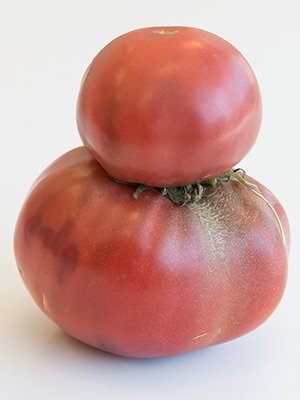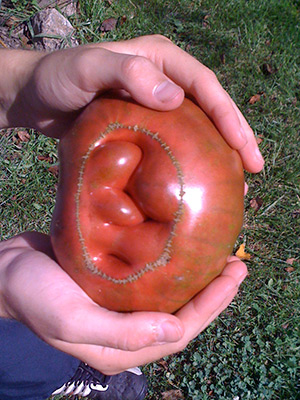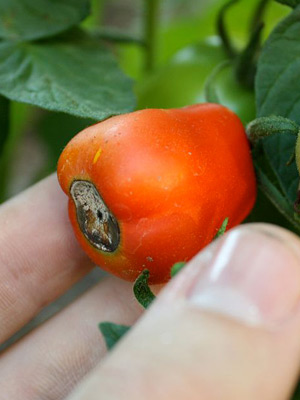Tomato Talk
A Full Season of Tomato-Growing Information
Early Season Problems
The top questions we get on tomatoes point to two main topics: "my tomatoes are funny-looking" and "why don't I have as many tomatoes as last year"? Here are some answers about cracked tomatoes, catfacing, blossom-end rot, and other oddities—plus tips to increase production.

Fasciated tomato fruits

Catfacing on a tomato

Blossom end rot by A13ean (Own work) [CC BY-SA 3.0], via Wikimedia Commons
Why are my tomatoes growing together?
A fasciation of flowers can cause two fruits to fuse and grow together. This phenomenon can occur in many different fruits. Genetics, bacteria, fungal or viral problems, the environment, and herbicide damage can cause the fasciation of plant parts.
What are the strange seams on my tomatoes?
The malformation in these tomatoes is called catfacing. It occurs on the blossom end of the fruit. Conditions during bloom—such as extreme temperature fluctuation, herbicide injury, and drought—can cause tomatoes to be malformed, scarred, and puckered. It usually only happens on the first fruits that form and not on later crops. Some varieties are more susceptible to this disorder than others.
Why are the bottoms of my tomatoes rotten or scabbed?
Blossom-end rot is caused by a calcium deficiency in the plant when the tomato fruit is setting. Rapid growth may inhibit calcium intake. While low soil pH is not usually a problem in the Chicago region, this can also be a cause. Drought stress or moisture fluctuations can also reduce calcium uptake into the plant. Adding crushed eggshells to your soil over time will help maintain calcium levels, but make sure to rinse them well to prevent attracting animals. Also check local laws first, as some towns have regulations against it.
How do I prevent my tomatoes from cracking?
Skin cracking is mainly caused by a fluctuation of soil moisture, especially as tomatoes ripen. If soil becomes dry and plants then receive heavy rainfall or heavy irrigation, the plants will take up water quickly and put on a growth spurt. This type of fast growth causes the skin to crack. Tomato cracks can be avoided by applying a few inches of organic mulch around the plants to prevent the soil from becoming overly dry, and watering tomatoes in the early morning.
Why didn't my tomato plants produce much fruit last year, and what can I do about it this year?
There can be several reasons to explain low fruit production:
- Sometimes flowers drop off the plant during periods of fluctuating temperatures. Temperatures above 90 degrees Fahrenheit during the day can cause the blossoms to drop without setting fruit. If evening temperatures fall below 55 degrees, remain above 75 degrees, or if the humidity is too high, blossoms can also drop prematurely.
- Tomatoes are pollinated by wind or insects. During extreme weather conditions, there can be low populations of insects, which will result in low fruit production.
- Shallow watering can stress and weaken tomato plants. Soil kept uniformly moist will promote the development of a large, healthy root system and will result in good fruit production.
- High nitrogen fertilization encourages vegetative growth and can inhibit flower production, resulting in poor fruit set. Low nitrogen produces spindly vines that cannot support proper plant development.
- Fungal problems can also prevent high yields as well as high-quality fruit, especially during seasons with periods of heavy rainfall. Gardeners may need to apply fungicide sprays if these diseases threaten to severely defoliate plants. Contact Plant Information Service at @email to request a list of approved fungicides.

